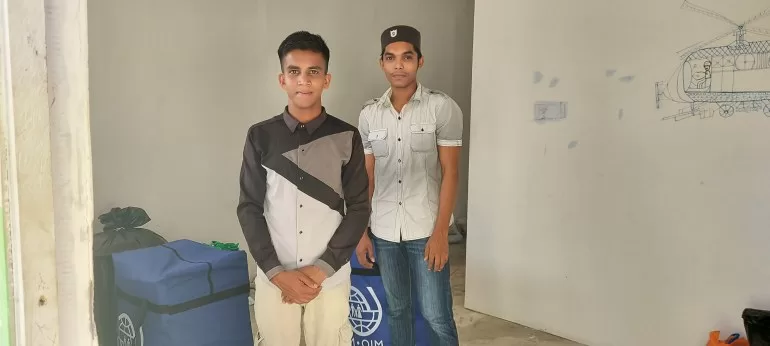It was the early months of the COVID-19 pandemic, and Malaysia had locked down and sealed its borders, but the people smugglers were hoping that the virus would quickly die down and border control would relax, Amin said.
They waited. Bobbing aimlessly on the water as the weeks passed, food became an increasing source of torment for the refugees on board.
To begin with, they had had rice and small, stale cakes that they washed down with instant coffee made with bottled water, and the smugglers had also brought sacks of onions that they sometimes ate. But no one had planned for weeks of delay. The rations dwindled. “After two months, it was very difficult,” Amin said.
The refugees had set up a tarpaulin to protect them from the sun, and when it rained, they would try to collect the water that had accumulated there, funnelling it into the empty bottles. But it was never enough.
“Near the end, the people smugglers would feed us one handful of rice per day and half a glass of water. We were so hungry and thirsty all the time,” said Amin.
Conditions were so harsh that Amin estimates “maybe about 100 people” died.
He told Al Jazeera that an old man he had seen begging the smugglers for water died two hours after his request was denied. A young boy, perhaps two or three years old, died the same way, Amin said, after crying out for water for several hours.
The bodies of the dead were tipped over the side; stripped naked before they went into the sea. Like food and water, clothes were considered a precious commodity – the refugees had only been allowed to bring what they were wearing.
“We were crying so much on that ship,” Amin said. “We were like skeletons.”
Amin said that there were maybe six or seven people smugglers on board and they were armed with sticks and guns. “The sailors were infidels [non-Muslims],” Amin said. “Some had come from Myanmar and some from Bangladesh but they said to us that they had been at sea for many years doing that job [people smuggling]. Their journey smuggling people had lasted for a very long time, they said.”
We were crying so much on that ship
According to Amin and Mohammed Ullah, another young Rohingya he met during the journey, the smugglers used their weapons to intimidate the refugees into begging for more money from their families back in Bangladesh and Myanmar.
“Sometimes they would beat us and tell us to call our parents to transfer more money to them. We paid 5,000 Malaysian ringgit [$1,211] and after a few months at sea on the big boat, the smugglers asked for 5,000 Malaysian ringgit more,” Amin said.
In early June 2020, the smugglers decided to make another attempt to get to Malaysia, hoping pandemic restrictions had been lifted.
But the situation had gotten worse.
“There were Malaysian helicopters circling overhead,” Amin recalled. “The smugglers said: ‘We will not take you to Malaysia. Go now, we don’t care.’”
Amin says it was at that point that the smugglers decided to split the group up, betting that a smaller number of people would have a better chance of making it ashore.
The refugees were put into four boats, each with one smuggler. Two drifted in the direction of the Malaysian resort island of Langkawi and two towards the coast of Aceh in Indonesia – one a larger, slower vessel, and the others smaller and faster.
On June 8, Malaysia’s coastguard announced it had detained 269 refugees off the coast of Langkawi after their boat’s engine failed. Fifty of the Rohingya, desperate to get onto dry land, jumped into the water and swam for the shore.
Four days later, Amin and Ullah’s boat was pushed back by the Malaysian coastguard.
The two men say they then drifted in the waters between Malaysia and Indonesia, as their meagre supply of food and water finally ran out. They were unaware that one of the other boats, carrying almost 100 refugees, had arrived in the Indonesian province of Aceh on June 24. Having been at sea for so long, some could barely walk. All were desperately hungry and thirsty. Even now, no one knows what happened to the fourth boat.
Al Jazeera was not able to locate the smugglers to speak to them about Amin and Ullah’s experience at sea. The two refugees’ accounts echo the experiences of others who have made the journey.
It was only in September that Amin’s boat was finally spotted by local fishermen – not far from the coastal town of Lhokseumawe.
The Indonesian authorities allowed them to land and even gave the Rohingya some assistance.
They were taken to a complex of basic, concrete buildings, with communal shower and toilet facilities and the air of an army barracks, only a 10-minute drive from the coast.
It was by no means luxurious, but it was dry land and it was safe.
“I was extremely glad to have landed in Aceh,” Amin recalled of his arrival. “As were the others who were in the same boat.”
